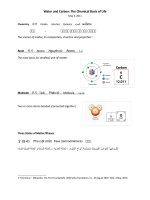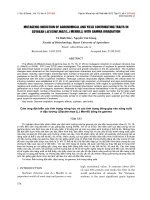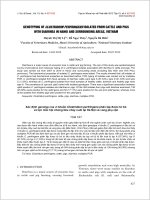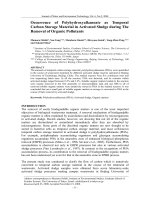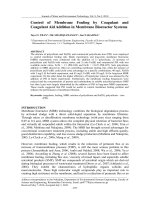carbons and carbon supported catalysts in hydroprocessing
Bạn đang xem bản rút gọn của tài liệu. Xem và tải ngay bản đầy đủ của tài liệu tại đây (14.31 MB, 174 trang )
Carbons and Carbon-Supported Catalysts in Hydroprocessing
RSC Catalysis Series
Series Editor
Professor James J Spivey, Louisiana State University, Baton Rouge, USA
Advisory Board
Krijn P de Jong, University of Utrecht, The Netherlands, James A Dumesic, University of
Wisconsin-Madison, USA, Chris Hardacre, Queen’s University Belfast, Northern Ireland,
Enrique Iglesia, University of California at Berkeley, USA, Zinfer Ismagilov, Boreskov
Institute of Catalysis, Novosibirsk, Russia, Johannes Lercher, TU Mu
¨
nchen, Germany,
Umit Ozkan, Ohio State University, USA, Chunshan Song, Penn State University, USA
The Series is intended to provide an accessible reference for postgraduates and indus-
trialists working in the field of catalysis and its applications. Books will be produced
either as monographs or reference handbooks. The Series will cover research develop-
ments and applications of catalysis, in both academia and industry.
Titles in the Series:
Carbons and Carbon Supported Catalysts in Hydroprocessing
By Edward Furimsky, IMAF Group, Ottawa, Ontario, Canada
Visit our website at www.rsc.org/catalysis
For further information please contact:
Sales and Customer Care, Royal Society of Chemistry, Thomas Graham House, Science
Park, Milton Road, Cambridge, CB4 0WF, UK
Telephone: +44 (0)1223 432360, Fax: +44 (0)1223 426017, Email: sa
Carbons and Carbon-Supported
Catalysts in Hydroprocessing
Edward Furimsky
IMAF Group, Ottawa, Ontario, Canada
ISBN: 978-0-85404-143-5
A catalogue record for this book is available from the British Library
r Edward Furimsky, 2008
All rights reserved
Apart from fair dealing for the purposes of research for non-commercial purposes or for
private study, criticism or review, as permitted under the Copyright, Designs and Patents
Act 1988 and the Copyright and Related Rights Regulations 2003, this publication may not
be reproduced, stored or transmitted, in any form or by any means, without the prior
permission in writing of The Royal Society of Chemistry or the copyright owner, or in the
case of reproduction in accordance with the terms of licences issued by the Copyright Li-
censing Agency in the UK, or in accordance with the terms of the licences issued by the
appropriate Reproduction Rights Organization outside the UK. Enquiries concerning re-
production outside the terms stated here should be sent to The Royal Society of Chemistry
at the address printed on this page.
Published by The Royal Society of Chemistry,
Thomas Graham House, Science Park, Milton Road,
Cambridge CB4 0WF, UK
Registered Charity Number 207890
For further information see our web site at www.rsc.org
Preface
Industrial carbons alone or in combination with various catalytically active
metals have been used in the studies of hydroprocessing of model compounds
and real feeds. The most frequently used carbons, such as activated carbon and
carbon blacks, were active for hydrogenation, hydrodesulfurization, hydro -
denitrogenation and hydrodemetallization. This activity is attributed to the
ability of carbons to facilitate activated adsorption of gaseous hydrogen. After
adsorption, active hydrogen is transferred to reactant molecules to initiate
hydroprocessing reactions. The hydrogen activation by carbons increases with
increasing temperature. Consequently, hydrogenation activity increases as well.
This is in contrast with equilibrium considerations which indicate that the
hydrogenation activity decreases with increasing temperature at the same H
2
pressure. This is one of the reasons for the different behavior of carbon sup-
ported catalysts compared with traditionally used g-Al
2
O
3
supported catalysts
containing the same amount of active metals. Because of the active hydrogen
present, carbon support is much more resistant to deactivation by coke
deposition than g-Al
2
O
3
support.
There is a significan t difference between the interaction of active metals with
carbon supports compared with oxidic supports, i.e. g-Al
2
O
3
supports. For the
former, during sulfiding, much weaker interaction favors the formation of
the Type II acti ve phase (e.g. Co-Mo-S) which is more active than the Type I
active phase. However, a pretreatment of carbon supports is necessary to
ensure an efficient dispersion of active metals during impregnation because of
the hydrophobic nature of the carbon surface. This problem can be also
overcome by employing impregnating solutions containing water soluble
organic agents. Because of the limited information on long term performance,
the stability of the active phase on carbon supported catalysts has not yet been
fully determined. Thus, because of the diminished interaction, sintering of
active metals is more likely to occur on carbon supported catalysts than on the
g-Al
2
O
3
supported catalysts unless a bonding between the active phase and the
carbon is facilitated. This would result in the presence of a new type of active
Carbons and Carbon-Supported Catalysts in Hydroprocessing
By Edward Furimsky
r Edward Furimsky, 2008
v
phase such as Co-Mo-C(S). Some experimental evidence supports coexistence
of such phases, i.e. Co-Mo-S and Co-Mo-C(S) phases, in hydroprocesisng
catalysts, particularly in those supported on carbons. The catalysts comprising
other oxidic supports (e.g., SiO
2
, SiO
2
-Al
2
O
3
, TiO
2
, zeolites, etc.) in com-
parison with carbon supported catalysts have been used to a much lesser extent.
The studies on carbon supported catalysts for hydroprocessing have been
dominated by conventional metals (e.g. Mo, W, Ni and Co), while less atten-
tion has been paid to other catalytically active metals. Among carbon supports,
activated carbon, carbon blacks and carbon black composites receive most
attention. The evidence supports growing interest in novel carbon supports
such carbon nan otubes, fullerenes, carbon nanofibers and nanoporous carbons.
The active phase in fresh catalysts, as wel l as during the experiments and at the
end of experiments has been characterized using spectroscopic techniques,
temperature programmed adsorption/desorption methods, surface science
techniques, etc. with the aim to define the structure and involvement of the
active phase during hydroprocessing reactions. Attention has been paid to
factors which are causing the decline in catalyst activity. Although to a lesser
extent, the non-conventional metals (e.g. Pt, Pd, Ru, Rh, Re and Ir) supported
on carbon supports were also studied as catalysts for hydroprocessing of model
feeds and real feeds. These catalysts were mu ch more active than conventional
metals containing catalysts. However, the high cost of these metals prevents
commercial utilization of these catalysts. Novel catalytic phases such as
metal carbides and phosphides, mostly containing conventional active metals
exhibited a good activity and stability when combined with carbon supports.
The activity of the carbon supported catalysts was determined using model
compounds and real feeds. The model compound studies consistently show
higher hydrodesulfurization and hydrodeoxygenation activities of carbon
supported catalysts than that of the g-Al
2
O
3
supported catalysts. Also, the
deactivation of the former catalysts by coke deposition was much less evident.
However, most of the model compound studies on hydrodesulfurization and
hydrodeoxygenation were conducted in the absence of nitrogen compounds,
although the poisoning effects of such compounds on hydroprocessing re-
actions has been well known. In fact, the information on hydrode nitrogenation
of model compounds over carbon supported catalysts is rather limited com-
pared with other hydroprocessing reactions. The advantages of carbon sup-
ported catalysts determined using model compounds were less evident for real
feeds of petroleum origin except for hydrodemetallization. For feeds of biomass
origin, carbon supported catalysts exhibited much higher activity and stability
than the g-Al
2
O
3
supported catalysts. Similar advantages of the former cata-
lysts are also expected for upgrading coal derived liquids. It should however
be noted that only a limited number of studies involved long-run testing of
carbon supported catalysts. Without the long-run performance determined,
potential of carbon supported catalysts for commercial applications cannot be
established.
Kinetics of hydroprocessing reactions, as well as kinetics of deactivation
over carbon supported catalysts have been investigated under a wide range of
vi Preface
experimental conditions. In most studies, the g-Al
2
O
3
supported catalysts have
been included for comparison. The difference between determined kinetic
parameters could be interpreted in terms of different mechanisms of hydro-
processing reactions. Thus , the radical-like mechanism is more likely to be
part of hydroprocessing reactions on carbon supported catalysts than on the
g-Al
2
O
3
supported catalysts.
In spite of the good activity and stability of the carbon supported catalysts
observed during the laboratory and bench scale studies, there is little evidence
supporting the use of these catalysts in commercial hydroprocessing oper-
ations. In this regard, additional information on long term performance using
pilot plant reactors is needed. A significant difference between the specific
gravity of a carbon support and that of a g-Al
2
O
3
support deserves attention
when commercial applications are considered. Thus, on weight basis, much
more of the carbon supported catalyst s than g-Al
2
O
3
supported catalysts
may be required to achieve similar performance. Nevertheless, the evidence
indicates the potential of carbon supported catalysts during hydroprocessing,
particularly in deep hydrode sulfurization and hydrodemetallization.
viiPreface
Contents
Chapter 1 Introduction 1
Chapter 2 Industrial Carbons
2.1 Carbon Black 4
2.2 Activated Carbon 6
2.3 Carbon Nanomaterials 8
2.4 Fullerenes 9
2.5 Diamond and Graphite 10
Chapter 3 Hydroprocessing Catalysts
3.1 Structure and Chemical Composition 12
3.1.1 Co(Ni)–Mo(W)–S Phase 13
3.1.2 Co–Mo–C(S) Phase 15
3.1.3 Effect of Support 16
3.2 Physical Properties 18
Chapter 4 Hydrogen Adsorption, Activation and Transfer by Carbons
4.1 Involvement of Carbons 22
4.2 Combined Effect of Carbon and Act ive Metals 30
4.2.1 Conventional Metals 30
4.2.2 Noble-Metal Catalysts 37
Chapter 5 Catalytic Activity of Carbons
5.1 Model Feeds 41
5.2 Real Feeds 44
Carbons and Carbon-Supported Catalysts in Hydroprocessing
By Edward Furimsky
r Edward Furimsky, 2008
ix
Chapter 6 Carbon-Supported Catalysts
6.1 Preparation of Carbon-Supported Catalysts 48
6.1.1 Pretreatment of Carbon Supports 48
6.1.2 Loading of Metals on Carbon Supports 51
6.2 Characterization of Carbon-Supported Catalysts 55
6.2.1 Spectroscopic Studies 55
6.2.1.1 Conventional Active Metals 56
6.2.1.2 Nonconventional Active Metals 60
6.2.2 Adsorption/Desorption Methods 63
6.3 Activity of Carbon-Supported Catalysts 63
6.3.1 Conventional Catalysts 71
6.3.1.1 Testing Using Model Compounds 71
6.3.1.2 Petroleum Feeds 83
6.3.1.3 Coal-derived Liquids (CDL) 87
6.3.1.4 Biocrude Components 89
6.3.1.5 Uncommon Feeds 92
6.3.2 Nonconventional Active Phases 92
6.3.2.1 Model Feeds 92
6.3.2.2 Real Feeds 101
6.3.3 In-situ made Carbon-Supported
Catalysts 103
Chapter 7 Kinetics and Mechanism of Hydroprocessing Reactions
over Carbon and Carbon-Supported Catalysts
7.1 Kinetics 105
7.1.1 Model Feeds 106
7.1.2 Petroleum Feeds 109
7.1.3 Biofeeds 111
7.2 Mechanism 113
7.2.1 HYD of Aromatics 114
7.2.2 HDS Reactions 115
7.2.3 HDN Reactions 118
7.2.4 HDO Reactions 122
7.2.5 HDM Reactions 123
Chapter 8 Catalyst Deactivation
8.1 Deactivation Involving Model Feeds 127
8.2 Deactivation Involving Real Feeds 131
x Contents
Chapter 9 Patent Literature 135
Chapter 10 Conclusions 137
References 139
Subject Index 151
xiContents
List of Acronyms
AC Activated carbon
AGO Atmospheric gas oil
APD Average pore diameter
AR Atmospheric residue
ASA Amorphous silica-alumina
BE Bond energy
BPh Biphenyl
BT Benzothiophene
CB Carbon black
CBC Carbon-black composites
CCR Conradson carbon residue
CDL Coal-derived liquids
CNF Carbon nanofibers
CNT Carbon nanotubes
CUS Coordinatively unsaturated sites
DAO Deasphalted oil
DBT Dibenzothiophene
DES Diethyl sebacate
DMDBT Dimethyl dibenzothi ophene
DMS Dimethyl sulfide
DOC Dynamic oxygen chemisorption
EDAX Energy dispersion analys is with X-rays
EXAFS Extended X-ray absorption fine spectroscopy
FCC Fluid catalytic cracking
FT-IR Fourier transform infr ared
GB Glass beads
GC-MS Gas chromatography-mass spectroscopy
GUA Guaiacol
HAADF-STEM High-angle annular dark-field scanning transmission
electron microscopy
HCR Hydrocracking
HDA Hydrodearomatization
HDAs Hydrodeasphalting
HDM Hydrodemetallization
xii
HDN Hydrodenitrogenation
HDO Hydrodeoxygenation
HDS Hydrodesulfurization
HDV Hydrodevanadization
HGO Heavy gas oil
HRTEM High-resolution transmission electron spectroscopy
HYD Hydrogenation
INS Inelastic scattering spectroscopy
LHSV Liquid hourly space velocity
MA Methyl acetophenone
MDBT Methyl dibenzothiophene
MOS Mossbauer spectroscopy
MTPP Methyl tetraphenyl porphyrin
MWCNT Multiwall carbon nanotubes
NM Noble metals
NPC Nanoporous carbon
PAH Polyaromatic hydrocarbons
QTOF Quasiturnover frequencies
PTOF Pseudo-turnover frequencies
RFCC Residue fluid catalytic cracking
SARA Saturates aromatics resins and asphaltenes
SEM Scanning electron microscopy
STM Scanning tunneling microscopy
TEM Transmission electron microscopy
THF Tetrahydrofuran
TMS Transition-metal sulfides
TOF-SIMS Time-of-flight secondary ion mass spectroscopy
TPD Temperature-programmed desorption
TPO Temperature-programmed oxidation
TPR Temperature-programmed reduction
VGO Vacuum gas oil
VR Vacuum residue
XAFS X-Ray absorption fine structure
XANES X-Ray absorption near-edge structure
XPS X-Ray photoelectron spectroscopy
XRD X-Ray diffraction
xiiiList of Acronyms
CHAPTER 1
Introduction
Carbon materials have been attracting attention as potential supports in
heterogeneous catalysis. Thus, only in 2006, the number of articles dealing
with various types of catalysts supported on carbon approached 1000.
Among these, only a fraction was devoted to hydroprocessing catalysts. It is,
however, emphasized that interest in carbons as supports for hydroproces-
sing catalysts began more than two decades ago. The available information
indicates some beneficial effects, although overall, there might be some limi-
tations on the use of carbon materials as the supports for hydroprocessing
catalysts.
Carbons that are used industrially exist in a highly ordered crystalline form
(diamond and graphite) and a less ordered amorphous form. Figure 1 depicts
models of these carbons. Amorphous forms of carbons such as carbon black
(CB) and activated carbon (AC) have been used in various industrial appli-
cations most extensively.
1
Novel carbon materials, e.g., carbon nanotubes
(CNT), fullerenes, etc. have been developed. The information on the individual
types of carbon is so extensive that a separate book can be written on each of
them.
In catalysis, AC, CB, CB composites (CBC), graphite and graphitized ma-
terials have been attracting attention as potential supports for precious metals
containing catalysts used for hydrogenation (HYD) of various organic com-
pounds.
2
Because of a weak interaction, a true alloy phase can be created from
different metals on some carbon surfaces.
3
This enhances the dispersion of metals
and their utilization during alloy catalysis. To some extent, surface defects on
carbon supports may be responsible for the interaction with metals.
4
Such
alloys cannot be formed on oxidic supports because of their much stronger
interaction. An increasing number of studies indicating potential application of
carbon supports, particularly those of AC and CB, in hydroprocessing catalysis
have been noted. Carbon fibers and CNT have been attracting attention as
well, whereas so far little information supports the use of fullerenes in hydro-
processing applications.
Carbons and Carbon-Supported Catalysts in Hydroprocessing
By Edward Furimsky
r Edward Furimsky, 2008
1
Although the primary focus of this review was carbon and carbon-supported
catalysts, attempts have been made to identify the difference in the effect
of carbon supports compared with the oxidic supports, particularly that of
g-Al
2
O
3
. It has been noted that many studies had the same objective. For this
purpose, the difference in catalyst activity and stability was estimated using
both model compounds and real feeds under variable conditions. The con-
ditions applied during the preparation of carbon-supported catalysts have
Figure 1 Approximate structures of industrial carbons.
2 Chapter 1
received attention as well. This included various methods of pretreatment of
carbon supports to enhance catalyst performance. In spite of all these efforts,
commercial utilization of the carbon-supported catalysts in hydroprocessing is
rather limited. In this regard, additional research may be needed to identify
suitable applications.
Because of the neutral nature and little interaction with active metals, carbon
supports are suitable to study the structure of active phase without interference
as is usually the case of oxidic supports. Consequently, the understanding of the
active phase in hydroprocessing catalysts was significantly advanced. Carbons
alone exhibit activity in some hydroprocessing reactions. The ability of carbons
to adsorb and activate hydrogen may be the origin of their catalytic activity.
3Introduction
CHAPTER 2
Industrial Carbons
A cursory account of the carbon types (AC, CB, CBC, CNT, fullerenes and
graphite) that have been attracting attention for potential applications in
hydroprocessing catalysis is given, with focus on the properties and methods of
preparation, as well as some industrial applications.
2.1 Carbon Black
Figure 1 shows that CB is an amorphous solid characterized by degenerate or
imperfect graphitic structures. In these structures, the angular displacement of
one layer with respect to another is random and the layers overlap irregularly
thus, forming a turbostratic structure. Within the particles of CB, the crystal-
lites are arranged randomly. The microstructure of CB aggregates consists of a
concentric arrangement of layer planes, with the interior of the aggregate being
less ordered than the exterior. Also, the interior is more chemically reactive and
has a lower density. Thus, during exposure to O
2
, the oxidation begins at the
interior of the aggregate. Structure, determined by the size and shape, as well as
the number of particles per aggregate, is another important parameter of CB.
The structure influences packing and volume of voids in the aggregate.
Chemically, carbon blacks contain about 99% of carbon with hydrogen,
oxygen, sulfur, nitrogen and ash accounting for the rest. The content of the
noncarbon components determines the surface reactivity of CB. This depends
on the method of preparation and the origin of the feed from which CB was
made. The particle diameter of most of the CBs is less than 0.5 mm, i.e. a large
portion of the CB particles is in the nanosize range.
Carbon black is produced by partial combustion or pyrolysis of hydrocarbon
liquids or gases, although attempts have been made to produce carbon black
from coal.
5
Particle size, structure (aggregate size) and surface area are among
the important properties of CB. Structure refers to the size of the primary
Carbons and Carbon-Supported Catalysts in Hydroprocessing
By Edward Furimsky
r Edward Furimsky, 2008
4
aggregates. Thus, CB consisting of many prime particles with extensive
branching and chaining is referred to as a high structure, while CB with fewer
particles forming more compact units as low-structure blacks. The amorphous
nature of CBs results from a short residence time (o1 s) in the reaction zone, i.e.
not enough time was left for crystallization, in spite of rather high temperatures
employed (B1200 K).
Several dozen grades of CB have been available commercially. Among them,
a high-abrasion grade accounts for almost half of the CBs production. Other
grades include super-abrasion, intermediate super-abrasion, general purpose,
high modulus, semi-reinforcing and fast extrusion CBs. Large volumes of CB
have been consumed in the production of rubber (tire and nontire) and other
plastics. This is followed by the printing industry for production of various
inks. The commercial production of CB has been dominated by an oil-furnace
process. In this case, a heavy feed is pyrolyzed with the aid of heat produced by
combustion of natural gas. High yield (45 to 65%) and a wide range of grades
can be prepared by this process. The gas-furnace process has been gradually
displaced by the oil-furnace process. The former is based on the partial com-
bustion of natural gas in the refractory lined reactor. In this case, yields of
blacks are less than 30%.
In hydroprocessing catalysis, carbon blacks can be used either directly by
slurrying with a feed or used for the preparation of CBC that are suitable
supports for the catalyst preparation. The properties of some commercial CBs
are shown in Table 1 and that of CBC prepared from the former in Table 2.
6
Table 1 Properties of carbon blacks.
6
Carbon black APD, nm Pore volume, mL/g Surf. area, m
2
/g
SAF
25 1.0 140
Monarch 1300
13 1.7 670
Monarch 1100
14 1.4 260
Monarch 700
18 1.9 200
Ketjen EC
30 4.4 1010
Table 2 Properties of carbon-blac k composite supports.
6
Support Surf. area, m
2
/g
% surf. area
(meso-+macropores)
(r 4 1.5 nm)
Total pore vol.
mL/g
SAF-(4)*
150 50 0.8
Monarch 1300-(6)
460 80 1.1
Monarch 1100-(4)
130 90 0.9
Monarch 700-(4)
120 70 1.1
Ketjen EC-(5)
730 73 1.7
AC-Norit
800 25 0.8
Al
2
O
3
-Ketjen
270 95 1.9
5Industrial Carbons
The latter were prepared by the method developed by Schmitt et al.
7
based on
the mixing CB with a binder (e.g., partially polymerized furfuryl alcohol) fol-
lowed by a heat treatment at 383 K and additional heat treatment at 923 K in a
flow of nitrogen. The properties of the CBCs could be further modified by
oxidative treatment (e.g., with HNO
3
).
The use of CB as pore-forming material during preparation of the g-Al
2
O
3
support represents another application in hydroprocessing catalysis.
8
In this
case, CB of various particle size is mixed with g-Al
2
O
3
. After forming the
particle shape of interest (e.g., extrudates) the g-Al
2
O
3
is calcined (at B820 K)
to remove all CB. The size of the resulting pores left behind depends on the
particle size of CB. g-Al
2
O
3
supports varying widely in pore-size distribution
can be prepared using this method.
2.2 Activated Carbon
Activated carbon is another amorphous, noncrystalline form of carbon pos-
sessing a large number of micropores and a high surface. The latter may exceed
1000 m
2
/g. Properties of AC depend on pore volume and pore-size distribution,
as well as on the functional groups on the surface. Typically, pore size varies
between 10 to 100 A
˚
. If present, pores greater than 100 A
˚
serve as channels for
molecules entering micropores. Besides porosity, other important physical
parameters include particle-size distribution, attrition resistance, hardness and
density. Chemical properties of AC include ultimate analysis, ignition tem-
perature, ash and moisture content. Depending on the applications, industrial
AC are produced in the form of powder, granules, pellets and extrudates.
Extrudates are produced by pulverizing AC, mixing with a binder and ex-
truding. To enhance performance, AC is impregnated with various chemicals,
i.e. zinc salts, iodine and phosphorus compounds, elemental sulfur, iron salts,
silver, etc.
Low-cost feedstocks such as wood, nut shells, coal, petroleum coke, waste
materials, etc. can be used for the preparation of AC.
9
Depending on the
feedstock and preparation conditions, a great degree of variance in porosity
of AC can be established. Typically, the wood-derived AC is known for its
extensive macroporous structure, whereas the coal- based AC can adsorb high
molecular substances because of the suitable mesoporosity. Microporous AC
can be prepared from the nut-shells. Two principal methods for AC prepar-
ation include thermal activation and chemical activation. The former is car-
ried out in two stages, i.e. carbonization followed by activation . In the first
stage, the feedstock is pyrolyzed to drive off volatiles and to produce a high
carbon content char. The char is subsequently activated (from about 800 to
1400 K) using an oxidizing medium such as steam, CO
2
and diluted air.
During activation, oxidizing gas reacts with the char to form gaseous prod-
ucts (CO, CO
2
and H
2
). At the same time, channels and pores are created in
the interior of the char particle. For some applications, the AC prepared by
activation is subjected to an additional treatment, i.e. washing with water,
6 Chapter 2
nitric acid, hydrochloric acid, phosphoric acid, etc. to remove impurities. For
feedstocks such as sawdust and peat, an AC can be prepared by chemical
activation. In this case, the feedstocks are mixed with dehydration agents
(zinc chloride, phosphoric acid, sulfuric acid, etc.) to chemically decompose
the feedstock. Typically, the plastic mass prepared by mixing the feeedstock
with a chemical agent is kneaded before being extruded, dried and calcined.
The extrudates are then activated at about 900 K. During activation the
chemical agent, e.g., zinc chloride, is recovered an d recycled. Rotary kilns are
the most common types of reactors used for the preparation of AC, although
fluidized-bed reactors have been used as well.
With respect to industrial applications, ACs are grouped into gas-phase and
liquid-phase types. The former produced in a larger particle size (granular),
are used for removal of contaminants and condensible species from various
gaseous streams and effluents.
10
Mostly in a powdered form, AC is used in
liquid-phase applications to remove contaminants, e.g., water purification.
Recently, attempts have been made to use AC for removal of the most re-
fractory multi-ring thiophenic compounds from middle distillates.
11,12
In these
applications, the following selectivity order of the S-heterorings has been es-
tablished: BToDBTo4-MDBTo4,6-DMDBT. This order was maintained
regardless of the origin of AC. Apparently, the adsorption was dominated by
the molecular volume of the compounds. This suggests that the interaction
with the surface was more physical rather than chemical. Therefore, surface
properties such as surface area, pore volume and size distribution may de-
termine the efficiency of AC utilization. The same was confirmed in the study
of Zhou et al.
13a
using a model diesel fuel mixture and real diesel fuel. Using a
similar approach, Kim and Song
13b
used the mixture of DBT, 4,40DMDBT,
indole, quinoline, naphthalene and 1-me thyl naphthalene. In this study, the
AC alone, as well as the AC loaded with metals such as Cu, Ce, Ni, Fe and
Ag were tested. AC can be readily impregnated with the salts of catalytically
active metals providing that a suitable impregnation solution was used. The
properties of AC that were tested as supports for hydroprocessing catalysts
are shown in Table 3.
14
These results indicate a significant variability in the
pore volume and size distribution between the two samples of AC. Table 4
15
compares elemental analysis and physical properties of several carbons, i.e.
nanoparticles of carbon black (Ketjen black), granular AC particles of a
moderate and large surface area (Diahope, BP2000 and Max sorb 3060) and
the pitch-based AC fibers (ACF-OG). Compared with Table 3, a significantly
lower ash content of these carbons should be noted. Moreover, relatively large
content of O+S in some carbons in Table 4 suggests that these elements may
play some role during the impregnation of these carbons with active metals.
The presence of the O-containing groups (e.g., hydroxyl, carboxyl, carbonyl,
arylether, etc.) on the surface of AC was reported by Solar et al.,
16
although
the stability of such groups under typical hydroprocessing conditions has not
yet been invest igated. Similarly as CB, AC can be used as a pore-forming
material during the preparation of the g-Al
2
O
3
supports varying widely in
pore-size distribution.
8
7Industrial Carbons
2.3 Carbon Nanomaterials
This group of carbon materials includes nanotubes and nanofibers. These
materials have been attracting attention because of their rather unique prop-
erties, i.e. unusual strength as well as a high electrical and thermal conductivity.
Table 3 Properties of activated carbons.
14
Activated carbon
Property Darco Alfa
Surface area, m
2
/g
712 946
Real density, g/mL
1.990 2.072
Particle density, g/mL
0.676 1.023
Pore volume, mL/g
0.977 0.495
APD, A
˚
54 20
Carbon, wt.%
81.1 90.4
Hydrogen, wt.%
1.1 o0.5
Nitrogen, wt.%
7.6 0.9
Sulfur, wt.%
0.48 0.87
Ash, wt.%
10.04 3.39
Increm. pore volume, mL/g
Pore diameter range, A
˚
200–600
0.078 0.003
100–200
0.141 0.003
30–100
0.352 0.029
15–30
0.101 0.181
Increm. pore area, m
2
/g
Pore diameter range, A
˚
200–600
12 0.4
100–200
42 0.9
30–100
292 28
15–50
200 404
Table 4 Elemental analysis (D
afb
) and physical properties of carbon
supports.
15
Ash Pore size Surf. area
Carbon C H N O+S wt.% A
˚
m
2
/g
Ketjen black
99.3 0.3 0.1 0.3 0.6 30 1270
Diahope
94.9 0.5 0.1 4.5 2.4 13 1350
BP2000
92.6 0.4 0.1 6.9 1.2 15 1450
Max sorb 3060
89.9 0.6 0.2 9.3 0 10 3060
ACF(OG-5A)
89.6 1.1 0.7 8.3 0.3 – 480
ACF(OG-10A)
93.9 0.7 0.3 4.6 0.5 – 1060
ACF(OG-15A)
91.6 0.7 0.4 7.3 tr – 1500
ACF(OG-20A)
93.9 0.7 0.3 4.6 0.5 9 2150
(D
afb
) dry-ash-fee-basis.
8 Chapter 2
Carbon nanotubes are made up of a rolled-up graphite sheet and are avail-
able as single-walled (SWCNT) or multiwalled nanotubes (MWCNT).
The methods of preparation include arc discharge,
17–21
laser ablation
22,23
and
catalytic chemical vapor deposition.
24,25
The CNT with regular turbostratic
structures not covered with amorphous carbon could be prepared by selecting a
suitable catalyst and experimental conditions.
26
It is believed that graphite can
be partially converted to CNT by applying suitable radiation with the aim of
removing the aromatic sheet from the basal plane. Apparently, there is a
driving force for rolling of such sheets into CNT.
Carbon nanotubes can be readily dispersed in a solvent using ultrasound.
However, because of a strong van der Waals forces, they can quickly aggregate
and precipitate. This problem can be alleviated by various pretreatments.
27,28
For example, Table 5 sho ws the effect of HNO
3
on properties of nanotubes.
29
An increase in the content of carboxylic, lactone and hydroxyl groups was
noted. At the same time, the total amount of base was decreased to zero.
However, the CNT prepared by the template technique could be dispersed in
water without requiring any pretreatment.
30
The evaluation of CNT and the CNT-supported catalysts for potential
application in hydroprocessing catalysis deserves attention. So far, this topic
may still be in the early stages of research, although some initial attempts to use
nanotubes as the support for the preparation of hydroprocessing catalysts have
been noted. For example, the recent information indicates on potential appli-
cations of the CNT an d carbon nanofibers (CNF) in catalysis mainly as sup-
ports.
31
In this regard, the CNT and CNF with macroscopic shaping app ear to
be promising supports for catalysts being used either in a gas-phase or trickle-
bed mode. This shaping ensures stabile physical and chemical properties. Also,
when used in fixed-bed reactors, the problems associated with diffusion and
pressure drops are much less evident.
2.4 Fullerenes
Fullerenes represent a new form of carbon made up of 60 carbons (C
60
) con-
nected together by hexagons and pentagons as in a soccer ball. They are
Table 5 Properties of carbon nanotube.
29
CNT CNT
a
Surf. area, m
2
/g
180 246
Pore vol., mL/g
0.73 0.76
APD, nm
11 12
Total acidity, mol/g
8.4 Â 10
À6
6.4 Â 10
À4
Carboxyl, mol/g
1.9 Â 10
À6
2.4 Â 10
À5
Lactone, mol/g
1.2 Â 10
À7
4.3 Â 10
À6
Hydroxyl, mol/g
6.4 Â 10
À6
3.6 Â 10
À5
Total base, mol/g
1.7 Â 10
À5
0
a
CNT treated with HNO
3
.
9Industrial Carbons
commercially available from several suppliers with prices steadily decreasing
because of improvements in the methods of preparation.
27
Several books on
various aspect of fullerenes have been published
32
including an extensive review
on fullerenes and fullerene-based materials in catalysis.
33
The review published
by Olah et al.
34
focused on reactivity of fullerenes. Reactions included re-
duction, oxidation, alkylation and related reactions, reactions with neutral
bases, cycloaddition reactions, epoxidation and oxygenation, halogenation,
Friedel–Crafts fullerylation of aromatics, fulleration of aromatics, reactions
with free radicals and formation of metallic complexes. The reactivity for so
many reactions suggests that various modifications of the surface of fullerenes
are possible. An anionic form of fullerenes is a strong reducing agent and can
catalyze the reduction of nitrogen to ammonia.
35
There is little evidence indi-
cating the use of fullerenes and/or full erenes-supported catalysts in the studies
on hydroprocessing react ions. This may be attributed to a low surface area
and the lack of stability of the metal/C
60
materials.
36
However, the oxide-C
60
materials may enhance the complexation with metals, although this may be
affected at temperatures exceeding 600 K.
37a
The recent review of theoretical studies publ ished by Kemsley
37b
focused on
fullerene-like structures compri sing more than 60 carbon atoms, i.e. C
80
and
C
180
. It was suggested that such structures can associate with hydrogen to form
C
80
H
80
and C
180
H
180
compounds. For the latter, 120 hydrogen atoms were
outside the cage and 60 hydrogen atoms inside the cage. The potential of these
structures as catalysts in HYD reactions was indicated. In this regard, the study
published by Zhao et al.
37c
indicated that the C–H bonds in such structures
may be too strong to facilitate HYD reactions. However, the hydrogen binding
may be tuned in the desired manner to improve HYD. This was accomplished
by encapsulating metal dopants (e.g., Li, Be, Mg, Ca, Al, Se, etc.) in the cage of
fullerenes.
2.5 Diamond and Graphite
There is little information suggesting that diamond was ever tested for appli-
cation in hydroprocessing catalysis. It represents the highest level of crystal-
lization of carbon. Because of its hardness, crushing diamond to the particle
size required for catalyst preparation is not feasible. This of course would make
little sense because of the high value of diamond, as indicated by demands from
industry and other parts of society. Therefore, the structure of diamond is
shown in Figure 1 just to indicate the availability of another form of carbon.
Apparently, graphite can be pretreated to improve its suitability as the
support for catalyst preparation.
38
The pretreatment included partial com-
bustion followed by the additional oxidation using solutions of HNO
3
,Na
hypochlorite and H
2
O
2
. After pretreatments, the amount of active metals that
could be added to the support was enhanced. Li et al.
39
succeeded in prepara-
tion of the expanded graphite from flake graphite. The former was found to be
a suitable support for various catalysts. Moreover, catalytically active metals
10 Chapter 2
